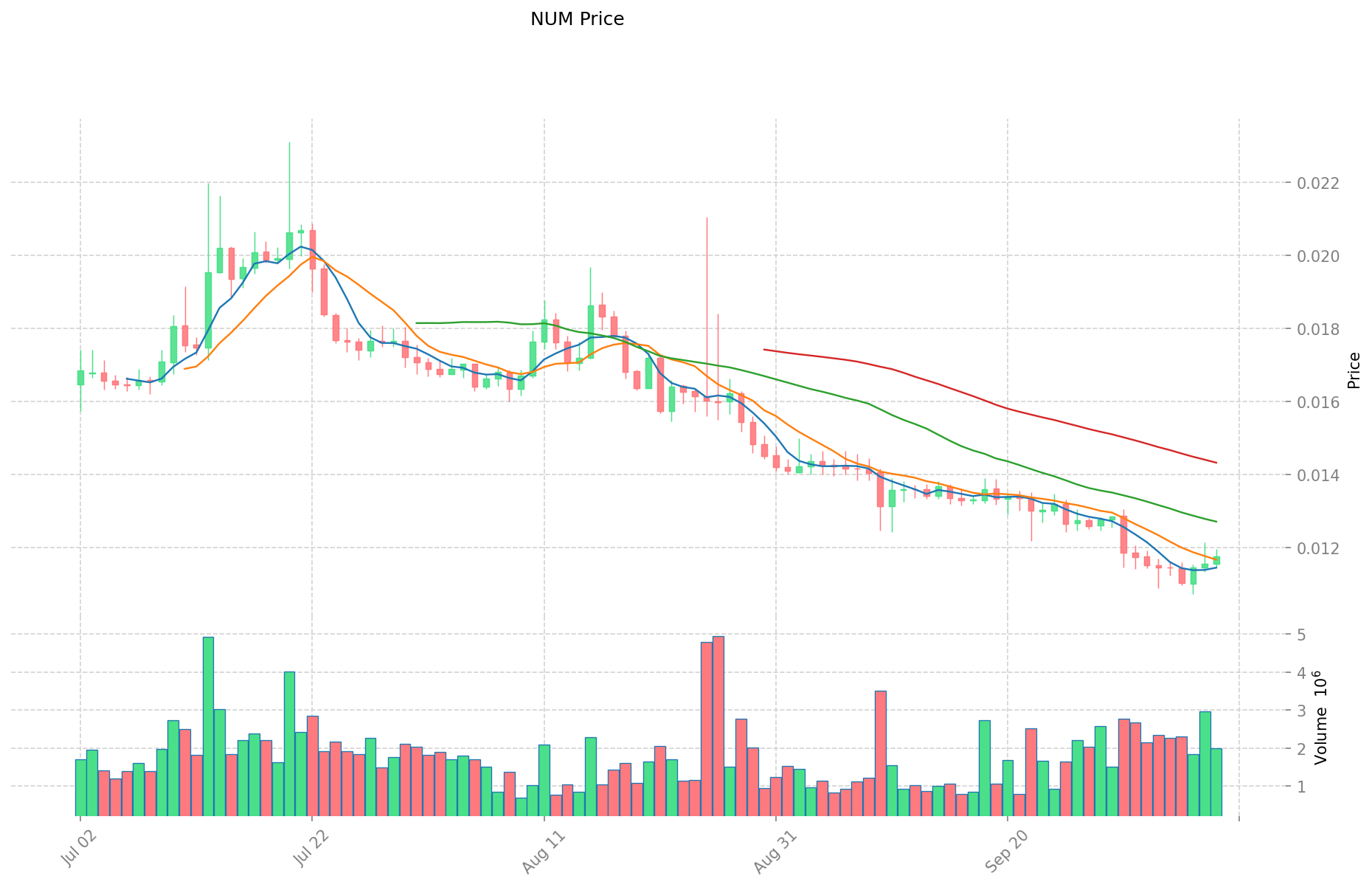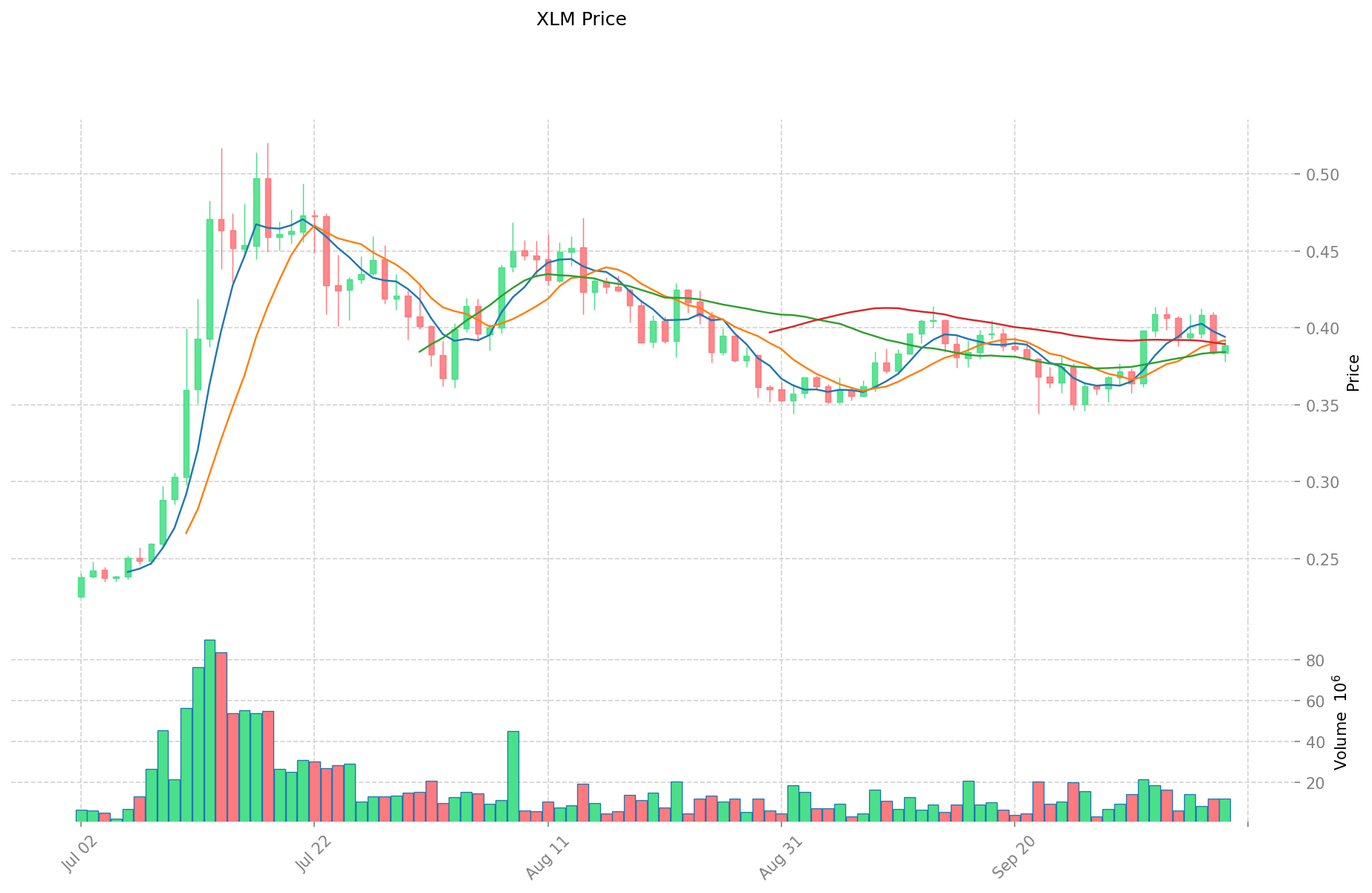NUM vs XLM: Comparing Two Leading Cryptocurrency Platforms for Cross-Border Transactions
Introduction: Investment Comparison of NUM vs XLM
In the cryptocurrency market, the comparison between Numbers Protocol (NUM) and Stellar (XLM) has always been a topic that investors cannot avoid. The two not only have significant differences in market cap ranking, application scenarios, and price performance, but also represent different positioning in crypto assets.
Numbers Protocol (NUM): Launched as a decentralized photo network that creates community, value, and trust for digital media.
Stellar (XLM): Launched in 2014, it has gained market recognition for its efficiency in cross-border payments and as a decentralized gateway for transferring digital assets between fiat and cryptocurrencies.
This article will comprehensively analyze the investment value comparison between NUM and XLM, focusing on historical price trends, supply mechanisms, institutional adoption, technical ecosystems, and future predictions, and attempt to answer the question that concerns investors the most:
"Which is the better buy right now?"
I. Price History Comparison and Current Market Status
NUM and XLM Historical Price Trends
- 2021: NUM reached its all-time high of $2.52 on November 28, 2021.
- 2014: XLM was launched by Jed McCaleb, co-founder of Ripple Labs.
- Comparative Analysis: During the recent market cycle, NUM dropped from its all-time high of $2.52 to a low of $0.01061784, while XLM has shown more stability with a current price significantly higher than its all-time low of $0.00047612.
Current Market Situation (2025-10-09)
- NUM current price: $0.01177
- XLM current price: $0.38824
- 24-hour trading volume: NUM $23,468 vs XLM $4,624,489
- Market Sentiment Index (Fear & Greed Index): 60 (Greed)
Click to view real-time prices:
- View NUM current price Market Price
- View XLM current price Market Price


II. Core Factors Affecting the Investment Value of XLM
Supply Mechanism (Tokenomics)
- XLM: Fixed supply of 50 billion tokens with no additional issuance, maintaining long-term scarcity and preventing inflation risk
- 📌 Historical pattern: The fixed supply mechanism has helped maintain XLM's value proposition in the payment sector despite intense competition and slow industry development pace.
Institutional Adoption and Market Applications
- Institutional holdings: XLM has garnered interest from financial institutions exploring cross-border payment solutions and CBDC initiatives
- Enterprise adoption: XLM focuses on cross-border payments, particularly for individuals and small businesses, while competing with XRP which targets larger financial institutions
- Regulatory policies: Regulatory environment has significant impact on XLM's price and adoption potential across different jurisdictions
Technology Development and Ecosystem Building
- XLM technology upgrades: Protocol improvements and strategic partnerships (like the 2021 collaboration with Ukraine's central bank) directly drive market demand
- Ecosystem comparison: XLM offers high-performance transfers (2-5 seconds) with minimal fees (0.00001 XLM), outperforming Bitcoin and Ethereum for small payments and cross-border transfers
- Platform capabilities: Support for multiple assets, allowing financial institutions to issue stablecoins or tokenized real-world assets (RWA)
Macroeconomic Factors and Market Cycles
- Performance during market trends: Strong correlation with Bitcoin price movements, particularly evident during Bitcoin's 2017 bull run
- Market structure factors: Liquidity conditions and leverage can amplify short-term price volatility
- External market environment: XLM price is influenced by broader cryptocurrency market trends alongside its internal fundamentals
III. 2025-2030 Price Prediction: NUM vs XLM
Short-term Prediction (2025)
- NUM: Conservative $0.0089376 - $0.01176 | Optimistic $0.01176 - $0.0150528
- XLM: Conservative $0.2753948 - $0.38788 | Optimistic $0.38788 - $0.5740624
Mid-term Prediction (2027)
- NUM may enter a growth phase, with prices estimated between $0.0157290588 and $0.02086169904
- XLM may enter a bullish market, with prices estimated between $0.53984207488 and $0.85670590144
- Key drivers: Institutional capital inflow, ETF, ecosystem development
Long-term Prediction (2030)
- NUM: Base scenario $0.02485062974394 - $0.027335692718334 | Optimistic scenario $0.027335692718334 - $0.027335692718334
- XLM: Base scenario $0.791899033920384 - $1.15617258952376 | Optimistic scenario $1.15617258952376 - $1.15617258952376
Disclaimer
NUM:
| 年份 | 预测最高价 | 预测平均价格 | 预测最低价 | 涨跌幅 |
|---|---|---|---|---|
| 2025 | 0.0150528 | 0.01176 | 0.0089376 | 0 |
| 2026 | 0.019707408 | 0.0134064 | 0.008982288 | 13 |
| 2027 | 0.02086169904 | 0.016556904 | 0.0157290588 | 40 |
| 2028 | 0.0245091849912 | 0.01870930152 | 0.01403197614 | 58 |
| 2029 | 0.02809201623228 | 0.0216092432556 | 0.013181638385916 | 83 |
| 2030 | 0.027335692718334 | 0.02485062974394 | 0.014661871548924 | 111 |
XLM:
| 年份 | 预测最高价 | 预测平均价格 | 预测最低价 | 涨跌幅 |
|---|---|---|---|---|
| 2025 | 0.5740624 | 0.38788 | 0.2753948 | 0 |
| 2026 | 0.692598528 | 0.4809712 | 0.355918688 | 23 |
| 2027 | 0.85670590144 | 0.586784864 | 0.53984207488 | 51 |
| 2028 | 0.7794850133376 | 0.72174538272 | 0.4546995911136 | 85 |
| 2029 | 0.833182869811968 | 0.7506151980288 | 0.405332206935552 | 93 |
| 2030 | 1.15617258952376 | 0.791899033920384 | 0.657276198153918 | 103 |
IV. Investment Strategy Comparison: NUM vs XLM
Long-term vs Short-term Investment Strategies
- NUM: Suitable for investors focusing on decentralized photo networks and digital media ecosystems
- XLM: Suitable for investors interested in cross-border payments and financial inclusion
Risk Management and Asset Allocation
- Conservative investors: NUM: 20% vs XLM: 80%
- Aggressive investors: NUM: 40% vs XLM: 60%
- Hedging tools: Stablecoin allocation, options, cross-currency portfolios
V. Potential Risk Comparison
Market Risks
- NUM: Higher volatility and lower liquidity compared to XLM
- XLM: Susceptible to broader cryptocurrency market trends
Technical Risks
- NUM: Scalability, network stability
- XLM: Network upgrades, potential vulnerabilities in smart contracts
Regulatory Risks
- Global regulatory policies may impact both differently, with XLM potentially facing more scrutiny due to its focus on financial transactions
VI. Conclusion: Which Is the Better Buy?
📌 Investment Value Summary:
- NUM advantages: Unique positioning in digital media, potential for growth in niche market
- XLM advantages: Established presence in cross-border payments, institutional adoption, higher liquidity
✅ Investment Advice:
- New investors: Consider a small allocation to XLM as part of a diversified crypto portfolio
- Experienced investors: Explore a balanced approach with both NUM and XLM based on risk tolerance
- Institutional investors: Focus on XLM for its potential in cross-border payments and financial applications
⚠️ Risk Warning: Cryptocurrency markets are highly volatile. This article does not constitute investment advice. None
VII. FAQ
Q1: What are the key differences between NUM and XLM? A: NUM is a decentralized photo network focused on digital media, while XLM is primarily used for cross-border payments and as a bridge between fiat and cryptocurrencies. XLM has a larger market cap, higher trading volume, and more institutional adoption compared to NUM.
Q2: Which cryptocurrency has shown better price stability? A: Based on historical data, XLM has demonstrated more price stability compared to NUM. XLM's current price is significantly higher than its all-time low, while NUM has experienced a more substantial drop from its all-time high.
Q3: How do the supply mechanisms of NUM and XLM differ? A: XLM has a fixed supply of 50 billion tokens with no additional issuance, which helps maintain its long-term scarcity. The supply mechanism for NUM is not explicitly stated in the provided information.
Q4: What are the main use cases for XLM? A: XLM is primarily used for cross-border payments, especially for individuals and small businesses. It also serves as a decentralized gateway for transferring digital assets between fiat and cryptocurrencies, and supports the issuance of stablecoins and tokenized real-world assets.
Q5: How do the price predictions for NUM and XLM compare for 2030? A: For 2030, NUM's base scenario price range is predicted to be $0.02485062974394 - $0.027335692718334, while XLM's base scenario range is $0.791899033920384 - $1.15617258952376. XLM is projected to have a higher potential price increase compared to NUM.
Q6: What are the recommended asset allocation strategies for NUM and XLM? A: For conservative investors, a suggested allocation is 20% NUM and 80% XLM. For aggressive investors, the recommended allocation is 40% NUM and 60% XLM. However, these allocations should be adjusted based on individual risk tolerance and investment goals.
Q7: What are the main risks associated with investing in NUM and XLM? A: Both cryptocurrencies face market risks, with NUM potentially experiencing higher volatility and lower liquidity. Technical risks include scalability and network stability for NUM, and potential vulnerabilities in smart contracts for XLM. Regulatory risks may affect both, with XLM potentially facing more scrutiny due to its focus on financial transactions.
Share
Content